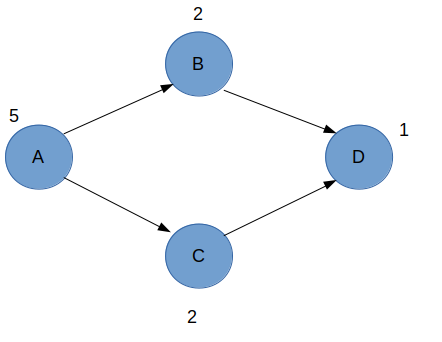Given a directed graph, suppose we want to find the number of reachable nodes from each node of the graph then what is the best way to solve this problem ??
One obvious way to solve it is doing dfs from every node of the graph and counting how many nodes are getting visited, but the problem with this approach is that it is O(n^2) where n is the number of nodes in the graph
Then i thought of maybe if we can store at each node how many nodes are reachable and when queried give the answer based on the values of the neighbouring nodes but this will not be able to handle the case of overcounting as in the graph below. 
So how to solve this ?











As far as I know the question of "is it possible to solve that faster than quadratic time" is an open problem.
If the graph is a DAG, you can just topsort and do dp.
If not just use Kosaraju Algorithm to condense SCCs, then use topsort + dp.
This should be linear. Or am I missing something?
How would you solve the problem on a DAG using dp?
This is a natural first instinct. However, this ends up overcounting.
Such dp counts the number of paths starting from some vertex, but sadly there might be more than one path with the same endpoints.
I see. Thanks.
You can optimize $$$O(n^2)$$$ with bitsets. If doing straightforward, this probably will give MLE (if n = $$$10^5$$$, ML = 256/512MB), but you can try to divide all vertices on groups, and for each group G runs separate dfs: for each vertex V count how many of vertices U(from G) are reachable from V.
Spoj Problem DAGCNT2 is similar to this
Can you also tell about the correct approach to this problem
By using Bitsets overcounting of nodes can be prevented. Then it can be solved by toposort.
Here is the code with explanation
Is there any use of topological sorting in this algorithm, or by using simple dfs also you can maintain the reach for every node
This can be done by first finding Strongly Connected Components (SCC), which can be done in O(|V|+|E|). Then, build a new graph, G', where each SCC is a node in the graph and each node has value which is the sum of the nodes in that SCC.
Given a graph G(V, E), we build G'(V', E') where:
V' = { U1, U2, ..., Uk | U_i is a SCC of the graph G }
E' = { (U, W) | there is node u in U and w in W such that (u, w) is in E }
This graph, G', is a DAG and the question becomes similar with finding the number of nodes reachable from each node in a DAG, which can be made easily via DFS:
So for the original nodes from G we get very easily the number of reachable nodes:
Thus the final complexity is linear O(|V| + |E|) .
It double counts
Oh, yeah, sorry about that, it seems it doesn't cover all the cases, my bad :///
All good, Note in the case that G is a DAG, this code will calculate reachable[v] instead as the number of paths starting at node v, which can grow exponentially
Basically for every node it will be n^2. So total time complexity becomes n^3 right? @author
No, you are doing dfs for each node so it's $$$O(n^2)$$$
Doing dfs for a single node is n^2 in the worst case where we have all nodes connected with each other. So if we do dfs for all nodes, doesn’t it make it n*n^2 = n^3?
dfs from one node is (n+e) afaik . multiplying by n gives of n^2
But that e can be n^2 in worst case right. So basically if there are 5 nodes, every node can have 4 edges. So e is 20 which is close to n^2 right?
You should only visit every node once. Don't visit nodes twice.
Yes but reasonable graph problems usually have m=n , but you are right. Exact time complexity is $$$O(n(n+m))$$$